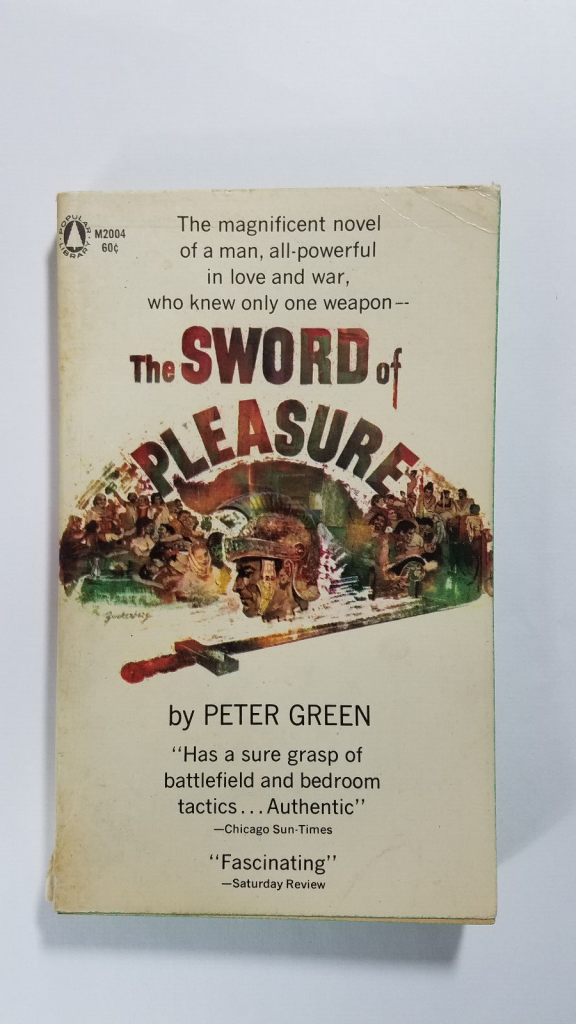 An interesting subset of historical novels are those written by historians. Peter Green (b. 1924) is known for books on the Classical Age. I have his Alexander to Actium and The Greco-Persian Wars on my shelves.
An interesting subset of historical novels are those written by historians. Peter Green (b. 1924) is known for books on the Classical Age. I have his Alexander to Actium and The Greco-Persian Wars on my shelves.
Green has written three historical novels. I have been meaning to track down and read The Sword of Pleasure for years. This is his second historical novel. Originally published in hardback in 1957, there was a Penguin paperback in 1961 in the U.K. and a U..S. paperback edition from 1962. There do not appear to be any more editions since then.
The Sword of Pleasure is a fictionalized account of the life of Lucius Cornelius Sulla (138- 78 B.C.). Sulla has a bad reputation, John Maddox Roberts’ SPQR novels mention Sulla’s proscriptions. Green gives Sulla’s side of the story. Read More
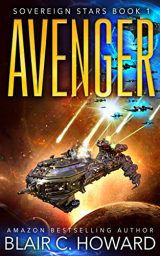 Avenger (Sovereign Stars #1) – Blair C. Howard
Avenger (Sovereign Stars #1) – Blair C. Howard
Five years after physicist Mark Holder discovered the Slipstream Drive in 2058, humanity reached for the stars and began to colonize the galaxy. For centuries, humans continued to populate system after system without encountering intelligent alien life.
Some twelve hundred years later, after many generations of relative peace, in the year 3278, human space is invaded by a powerful and mysterious enemy. To these invaders the very concept of free will is heresy. Their crusade—to eradicate humanity.
The war begins, and the fight for the survival of the human race is on.
Book 1 of Sovereign Stars, Avenger, is the first novel in a gripping, action-filled military space opera in which Avenger, under the command of Knight Captain Richard Morian, is sent to one of the outer star systems on a rescue mission. What he discovers there suggests the entire Orso Carrier Group is destined for annihilation.
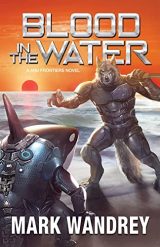 Blood in the Water (Four Horsemen Universe: The Frontiers #4) – Mark Wandrey
Blood in the Water (Four Horsemen Universe: The Frontiers #4) – Mark Wandrey
Five years ago, a group of human researchers and their mercenary friends helped evacuate 26 cetaceans from Earth just ahead of their arrest. The world government didn’t approve of their giving the cetaceans pinplants, and it wanted to euthanize the dolphins and orcas in their care.
After finding a home on the distant ice-covered ocean world of Hoarfrost, the humans and cetaceans settled in. Less than a year later, they were attacked when the planet’s previous owners, the aquatic Selroth, tried to regain possession of it. During the battle, Terry Clark was responsible for inadvertently uplifting the cetaceans, who then came to the aid of the Humans and helped defeat the Selroth.
The BotSha and KilSha, as they are now known, have lived a quiet life on Hoarfrost for the last four years, learning what it means to be an intelligent species, while Terry has learned the life of a mercenary.
But when they’re forced to give up Hoarfrost, Terry and his mercenary company will have to determine where they’re going to go and how they’re going to get the massive cetaceans to their new home. Unfortunately for them, they aren’t being forced to leave the planet so much as they’re being targeted for elimination. Ancient, infinitely wise, and powerful forces have discovered them, and they are out for blood.
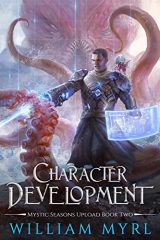 Character Development (Mystic Seasons Upload #2) – William Myrl
Character Development (Mystic Seasons Upload #2) – William Myrl
The Maker is dead. Who gets his stuff?
Hollen, Lawlimi, and their companions have been transferred to a new server, where they are quickly caught up in some of the same problems that plagued the original—the Acarus virus is on the rise, and Orobos’s ark is hovering over the world like a promise of doomsday. The creator of Mystic Seasons is dead, and his will dictates that whoever completes a hidden in-game quest will become his heir in a manner that is legally distinct from Ready Player One.
But when Hollen is separated from the party, low level and stuck with a squid for an avatar, he has to complete the quest on his own. He’ll need to become more than a mere advisor. He’ll need to be a hero in his own right. Read More
Sensor Sweep: Red Sonja, Titan Comics, D&D 2nd Edition
Monday , 7, November 2022 Sensor Sweep Leave a commentCinema (We’ve Got Back Issues): To put it bluntly, the road to Hollywood accepting that women can carry action movies has been as smooth as the back of a Stegasaurus with scoliosis, but as bad as things once were with such comic books movies spectacularly missing the point as Elektra and Catwoman, mismanaged female led fantasy flicks have been crashing and burning for a lot longer than that as 1985’s Red Sonja testifies.
accepting that women can carry action movies has been as smooth as the back of a Stegasaurus with scoliosis, but as bad as things once were with such comic books movies spectacularly missing the point as Elektra and Catwoman, mismanaged female led fantasy flicks have been crashing and burning for a lot longer than that as 1985’s Red Sonja testifies.
 Robert E. Howard (Sprague de Camp Fan): “The Mirrors of Tuzun Thune” was first published in Weird Tales, September 1929. It was reprinted in Skull-Face and Others, Arkham House, 1946. It was reprinted again in Avon Fantasy Reader #2, 1947. It also appeared in The Coming of Conan, Gnome Press, 1953. The first paperback appearance was in King Kull, Lancer Books, 1967.
Robert E. Howard (Sprague de Camp Fan): “The Mirrors of Tuzun Thune” was first published in Weird Tales, September 1929. It was reprinted in Skull-Face and Others, Arkham House, 1946. It was reprinted again in Avon Fantasy Reader #2, 1947. It also appeared in The Coming of Conan, Gnome Press, 1953. The first paperback appearance was in King Kull, Lancer Books, 1967.
Comic Books (CBR): Titan Comics is returning to the Hyborian Age with a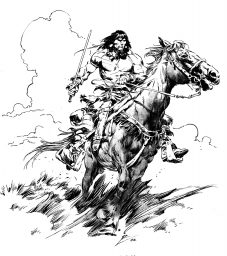 brand-new creative team behind Conan. CBR can exclusively reveal that Titan Comics, working alongside entertainment studio Heroic Signatures, will be co-publishing a new, ongoing Conan the Barbarian comic book series. Launching in July 2023, the series will see the return of longtime Conan scribe Jim Zub (Thunderbolts, Uncanny Avengers), and feature the artwork of illustrator Roberto De La Torre (King-Size Conan, Iron Man: Director of S.H.I.E.L.D.) and colorist José Villarrubia (Promethea, Sweet Tooth). Read More
brand-new creative team behind Conan. CBR can exclusively reveal that Titan Comics, working alongside entertainment studio Heroic Signatures, will be co-publishing a new, ongoing Conan the Barbarian comic book series. Launching in July 2023, the series will see the return of longtime Conan scribe Jim Zub (Thunderbolts, Uncanny Avengers), and feature the artwork of illustrator Roberto De La Torre (King-Size Conan, Iron Man: Director of S.H.I.E.L.D.) and colorist José Villarrubia (Promethea, Sweet Tooth). Read More
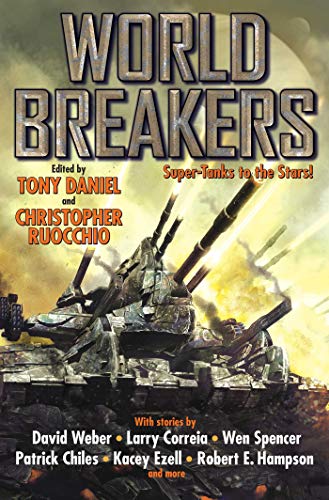 Military science fiction is a sub-genre that should be undergoing some changes due to introduced technology and weapon systems. World Breakers is an anthology Baen Books published in trade paperback in August 2021 and mass market paperback a couple months ago.
Military science fiction is a sub-genre that should be undergoing some changes due to introduced technology and weapon systems. World Breakers is an anthology Baen Books published in trade paperback in August 2021 and mass market paperback a couple months ago.
Subtitled “Super-Tanks to the Stars!,” this is an anthology of new military science fiction stories featuring armor. The introduction by Toni Weisskopf discusses the seeds of this anthology in the 1990s when Jim Baen discussed with Keith Laumer the idea for a novel on sentient tanks. Toni had mentioned the quote on social media which led to Tony Daniel and Christopher Ruocchio editing the resulting book. Read More
 The Demon’s Eye – Jon Del Arroz
The Demon’s Eye – Jon Del Arroz
A great evil has awakened.
War ravages the kingdoms of Hyrum and Tyril, strange apparitions are appearing everywhere, but the worst part of it all is Jayden finds himself at the center of an ancient prophecy.
He once fought for the evil Sorcerer King of Hyrum, but Jayden defected and renounced violence. His new life as a traveling bard makes him best suited to find the Harp of the Ancients and play their songs which will stave off Armageddon. But can he find the relic and learn their writ before the entire world is torn asunder?
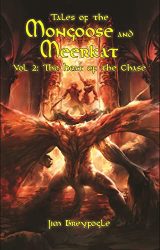 The Heat of the Chase (Tales of the Mongoose and Meerkat #2) – Jim Breyfogle
The Heat of the Chase (Tales of the Mongoose and Meerkat #2) – Jim Breyfogle
Mangos, the brash and somewhat impetuous swordsman, and Kat, the mysterious Alnessi rogue, have been adventuring together for a year now and are finally building a reputation as competent adventurers who can get the job done when the price is right.
The duo sets up shop in the city of Alomar, a place where anything can be bought and sold. While seeking patrons for future plans, the Mongoose and Meerkat turn old enemies into new allies, but there’s always a cost!
While Mangos seeks flashy wealth and fame, Kat has her eyes on bigger prizes… and making some new and powerful foes among the elites comes with the territory when the Crown of Alness is on the line!
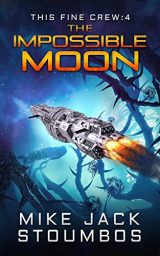 The Impossible Moon (This Fine Crew Book 4) – Mike Jack Stoumbos
The Impossible Moon (This Fine Crew Book 4) – Mike Jack Stoumbos
If it sounds too good to be true…
The Interstellar Initiative Starship Endeavor has been exploring stars and training cadets for almost a year, but their shaky reputation (and an unstable entity in their hull) could get them grounded any day. Or destroyed. Either is possible… and both are likely.
But then an opportunity presents itself which just might be a solution to their problems. In the Tsangharee cluster is a moon the locals revere as the source of a coveted power: universal communication. Having the ability to talk to the entity in Delta Section might well save everyone from losing their jobs, or worse, their lives.
Whether it’s magic or science, real or hoax, Ensigns Lidstrom, Kesiel, Paul Newman, and—if she plays her tiles right—Arrksh will be among the first to investigate. But when the opportunity to obtain this mysterious ability presents itself, will it be worth the price they have to pay? Read More
Gaming (Walker’s Retreat): IIOf course there’s the question of “Can I play this?” and the answer is “Yes.” This is the ruleset that Jon Mollison mentioned in his video that I posted the other day.
Review (John C. Wright): Crucifixion Press Resurrects Pulse-Pounding Pulp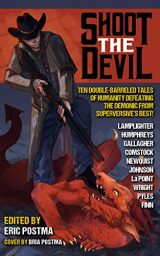 Action In The New Anthology, ‘Shoot The Devil’: Nearly a century later, Solomon Kane’s two-fisted spirit lives in an army of movies and television shows. From Hammer Films’ katana-wielding Captain Kronos, to Blade, Buffy and Dylan Dog, The Witcher, the Winchester brothers and Ash Vs The Evil Dead, to Exorcist Vengeance, Abraham Lincoln: Vampire Hunter and everything in between, the never-ending war on the forces of darkness continues unabated.
Action In The New Anthology, ‘Shoot The Devil’: Nearly a century later, Solomon Kane’s two-fisted spirit lives in an army of movies and television shows. From Hammer Films’ katana-wielding Captain Kronos, to Blade, Buffy and Dylan Dog, The Witcher, the Winchester brothers and Ash Vs The Evil Dead, to Exorcist Vengeance, Abraham Lincoln: Vampire Hunter and everything in between, the never-ending war on the forces of darkness continues unabated.
D&D (RPG Pundit): The latest data sure indicates that I’ve been right all along about the speeding up of D&D sales decline the more woke their garbage products become… Read More
 The annual October horror read continues with John Steakley’s Vampire$. Steakley (1951-2010) was not a prolific writer. He had two novels to his credit. The other is the well thought of science fiction novel Armor (1984).
The annual October horror read continues with John Steakley’s Vampire$. Steakley (1951-2010) was not a prolific writer. He had two novels to his credit. The other is the well thought of science fiction novel Armor (1984).
Vampires was first a Roc/New American Library trade paperback in late 1990. The mass market paperback followed in 1992. There were two more mass market printings (1998 and 2002) and trade paperback in 2008.
The plot is about a team of vampire hunters working for the Vatican. The novel starts with the team clearing out a nest of vampires in Indiana. Things were not quite right as the main vampire came out first instead of the “goons.” It all goes wrong when most of the team is wiped out that night while partying by a master vampire. Read More
 Previously, I discussed Asimov’s three kinds of science fiction: gadget, adventure, and social. And while this trio better describes the wild and wooly mess of science fiction than the binary set of hard and soft science fiction, new sub-genres have cropped up that don’t quite match the categories Asimov created. Now, Asimov’s categories are descriptions based on function, so many hybrids exist. But there still remains one category outside this spectrum.
Previously, I discussed Asimov’s three kinds of science fiction: gadget, adventure, and social. And while this trio better describes the wild and wooly mess of science fiction than the binary set of hard and soft science fiction, new sub-genres have cropped up that don’t quite match the categories Asimov created. Now, Asimov’s categories are descriptions based on function, so many hybrids exist. But there still remains one category outside this spectrum.
Most speculative fiction attempts to peer into the Great Unknown in the hopes of better understanding who were are and where we are going, as in Maurice Renard’s definition of the scientific-marvelous. But some speculative fiction dives into stranger alleys. What if Star Trek and its expendable redshirts were real? What if, after Sauron was defeated, he was forced to work at a McDonalds? What if a girl was reincarnated into the villain of her favorite visual novel? What if the Soviet Union sent AK-47s back in time to the Confederate South?
Welcome to gimmick fiction. Here, science is a worldbuilding conceit to be explored for all its consequences, no matter how mundane, glorious, or humorous the result may be. And while many of these stories are adventures in absurdity, all are unflinching in answering the question of “what if?” Like Asimov’s science fictions, this category hybridizes as well, most often with adventure, but much of alternate and counterfactual history blends into social science fiction.
The key to detecting gimmick fiction is determining if the story’s central conceit be reduced to a single question. Granted, this can be easier to see with light novel titles that shout out their gimmicks such as Reborn as a Vending Machine, I Now Wander the Dungeon, I’ve Been Killing Slimes for 300 Years and Maxed Out My Level, and The Devil is a Part-Timer!, but much of hard alternate and counterfactual history follows the same course. What if Sam Houston was not wounded at a key battle in his youth? What if the South won Gettysburg? And so on. But the consequences have to arise from this question. A simple reskinning of historical events into space opera, as David Drake and others are prone to do, lacks the wild exploration of consequences needed for gimmick fiction.
Gimmick fiction is a bending-inwards of speculation from the unknown to how the known changes if one assumption is changed. While it lends itself to humor and light adventure, it also lends itself to counterfactuals. If Asimov’s Three Kinds of Science Fiction can be boiled down to:
Gadget sci-fi: Man invents car, holds lecture on how it works.
Adventure sci-fi: Man invents car, gets into a car chase with a villain.
Social sci fi: Man invents car, gets stuck in traffic in the suburbs.
then gimmick fiction is:
Man invents car two thousand years early, chaos ensues.
And that chaos, especially in the realms of light science fiction, is the dominant mode of the day.
Science Fiction and Fantasy New Releases: 29 October 2022
Saturday , 29, October 2022 Uncategorized Leave a comment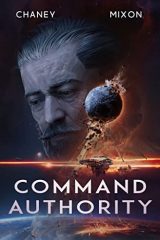 Command Authority (The Last Hunter #5) – J. N. Chaney and Terry Mixon
Command Authority (The Last Hunter #5) – J. N. Chaney and Terry Mixon
Victory snatched from the jaws of defeat.
Commodore Jack Romanoff and his ragtag crew have repaired their ancient battleship, scattered their adversaries at New Copenhagen, and discovered what was really behind the invasion. Now they must make the enemy bleed and begin liberating the cluster.
Betrayal from the shadows.
When someone unexpected conspires against him, Jack must keep his ship and crew united and safe. If he fails, someone powerful that should have had his back will stick a knife into it, and the aliens will enslave or exterminate them all.
Honor or victory? Can he have both?
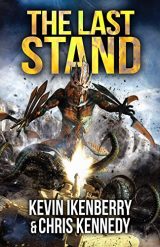 The Last Stand (The Guardian Covenant #1) – Kevin Ikenberry and Chris Kennedy
The Last Stand (The Guardian Covenant #1) – Kevin Ikenberry and Chris Kennedy
One last chance to save the world!
When the first asteroid was spotted heading toward Earth, no one thought much about it. But then a second one was found, and then a whole string. One might have been happenstance… but thirteen was enemy action!
But who was responsible for them? With asteroids bearing down on the U.S., China, and Russia, all the nations that could have done it were unlikely to have been the ones who actually caused the apocalypse headed toward Earth.
It was bad when the asteroids began hitting the planet, devastating the areas where they fell… but when 35-meter-tall monsters began climbing out of the impact craters, things quickly became far, far worse. And when they were found to be immune to most conventional weapons, everything went completely into the toilet.
With the alien hordes dominating the land and sky, though, humanity did what it did best—it created the Guardians, massive mecha that were able to take the battle to the aliens, and rushed them into production. But with four continents already about to fall, there was just one question—would they make a difference?
 Slayers #16 – Hajime Kanzaka
Slayers #16 – Hajime Kanzaka
So, a virtuoso sorcerer and a master swordsman walk into a bar…
Yeah, you’ve heard this one before.
The locals immediately hit ’em up for a job because they look sooo powerful and the town’s just that dang desperate for help.
In the case of Atessa, city of blacksmiths, there’s apparently some funny business going down in the surrounding woods. Mines are being attacked, caravans raided—the whole shebang.
Yup, there’s definitely something foul afoot in this forest.
Frankly, I don’t care to find out what, but if the price is right…
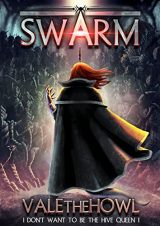 Swarm (I Don’t Want to be the Hive Queen #1) – ValeTheHowl
Swarm (I Don’t Want to be the Hive Queen #1) – ValeTheHowl
Survive. Build his Swarm. Dominate.
Think you’ve had a bad day at work? Marcus definitely takes the cake.
First, he had a horrible customer during his shift. Then he got fired by his boss. And after that, he got shot to death during a robbery. To top it all off, he awakened within the body of a weak and strange creature in a fantasy world full of deadly monsters.
And that’s just Monday!
Now Marcus will have to find a way to survive as a Vex Queen, but to do so his own bravery and determination are not enough. He needs to build a Hive that will protect him and the monsters are only the first of many threats to come…
Sensor Sweep: Steve Holland, Guy Gavriel Kay, Wizards, Giallo
Monday , 24, October 2022 Sensor Sweep 1 CommentArt (Steve Holland Book): While working on my upcoming book ‘Steve Holland: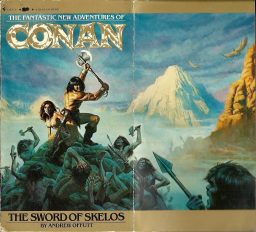 Paperback Hero’, I reached out to Bob Larkin to see if he could help me with a few of the many covers of Steve that he painted over the years. He sent me a gang of illustrations, including quite a few of Steve as Conan.
Paperback Hero’, I reached out to Bob Larkin to see if he could help me with a few of the many covers of Steve that he painted over the years. He sent me a gang of illustrations, including quite a few of Steve as Conan.
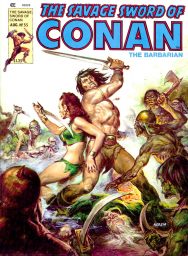 Robert E. Howard (Sprague de Camp Fan): “Wizard and Warrior” is an unfinished fragment by Robert E. Howard that was reworked by Lin Carter. It is the eleventh story in King Kull, Lancer Books, 1967. Presumably Lin Carter also titled the story.
Robert E. Howard (Sprague de Camp Fan): “Wizard and Warrior” is an unfinished fragment by Robert E. Howard that was reworked by Lin Carter. It is the eleventh story in King Kull, Lancer Books, 1967. Presumably Lin Carter also titled the story.
Fiction (Pulprev): “This is just like [Brand X]!” This is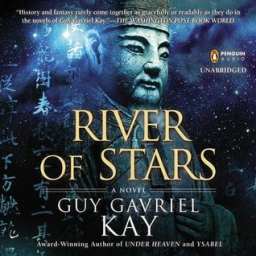 the most common sentence in modern fiction. It is also the most annoying sentence in modern fiction. Every time I encounter it in a story, I always roll my eyes, shake my head, and ignore the sentence. And usually the following paragraph too. Every reference to contemporary pop culture is a postule on the page, unworthy to be read and remembered. Read More
the most common sentence in modern fiction. It is also the most annoying sentence in modern fiction. Every time I encounter it in a story, I always roll my eyes, shake my head, and ignore the sentence. And usually the following paragraph too. Every reference to contemporary pop culture is a postule on the page, unworthy to be read and remembered. Read More
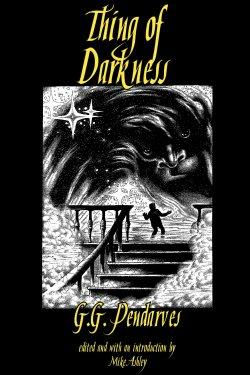 Gladys Gordon Trenery (1885-1938) as “G. G. Pendarves” had 19 stories in Weird Tales, seven stories in Oriental Stories/Magic Carpet Magazine, nine stories in Hutchinson’s Mystery Story Magazine, three stories in Hutchinson’s Adventure-Story Magazine, and one story in Argosy from 1923 to 1939.
Gladys Gordon Trenery (1885-1938) as “G. G. Pendarves” had 19 stories in Weird Tales, seven stories in Oriental Stories/Magic Carpet Magazine, nine stories in Hutchinson’s Mystery Story Magazine, three stories in Hutchinson’s Adventure-Story Magazine, and one story in Argosy from 1923 to 1939.
She lived in the Liverpool region of England with roots from Cornwall. She was one of the second stringers for Weird Tales. She was somewhat unique, an English spinster writing weird stories mostly for an American pulp magazine. She was not part of the Lovecraft circle nor a pulp fictioneer like Seabury Quinn, Otis Adelbert Kline, or Arthur J. Burks.
Over the years, I read maybe two stories reprinted in Weird Tales reprint anthologies. There is one one collection of her fiction Thing of Darkness from Midnight House, 2005. I bought this book around 2009 when Midnight House had a special if you bought four books. I have written about Eric Frank Russell’s Darker Tides and Joseph Payne Brennan’s The Feaster from Afar. I decided it was time to finally read this volume after years of sitting on the bookshelf. Read More
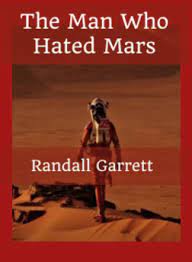 September 1956’s issue of Amazing Stories held within its pages a short story by Randal Garrett called “The Man Who Hated Mars.” It’s a bit of a morality story, following an inmate, one Ron Clayton, as he tries to flee Mars for the “Green Hills of Earth.” Mostly, he wrecks lives and spacecraft in that frenzied pursuit, even as he runs from the law and any reminder of what he once left behind.
September 1956’s issue of Amazing Stories held within its pages a short story by Randal Garrett called “The Man Who Hated Mars.” It’s a bit of a morality story, following an inmate, one Ron Clayton, as he tries to flee Mars for the “Green Hills of Earth.” Mostly, he wrecks lives and spacecraft in that frenzied pursuit, even as he runs from the law and any reminder of what he once left behind.
Just like any morality play, Clayton gets his comeuppance at the end, as, in his hubris, he forgot one key detail: the gravity of the situation.
Not of all the lives he stranded in hypoxia and the cold depths of space. Literal gravity–and the atrophy in musculature caused by the reduced gravity of Mars. Unable to move under his own strength, the very home he sought punishes him, with a near -certain exile to Mars.
No one said criminals were smart.
Perhaps this morality tale should be called a technology tale instead. The crimes are all very bloodless, with the post-Campbell eschewing of the horror needed for the instruction and catharsis of a proper morality tale. Even the just deserts are rendered in a stale official report. Without that horror, the reader is left with an unpleasant main character doing dastardly deeds without a reason to remain in such a vile presence. But what else does one expect from the great systemizing of fiction but the tyranny of the rules?
What is more of interest, however, than the relentless march of Newtons Sleep on the weird genres, is the meta aspects. Clayton is tormented by musical choruses of Robert Heinlein’s “The Green Hills of Earth.”
We rot in the molds of Venus,
We retch at her tainted breath.
Foul are her flooded jungles,
Crawling with unclean death.
That’s the first of several snippets Robert Heinlein wrote for the short story of the same name. But it’s not the first mention of “The Green Hills of Earth” as a ballad, or of lyrics to the song. For that, we must return to Mars, to a different version of the red planet, as told by Catherine Lucille Moore. To “Shambleau” and Northwest Smith humming “The Green Hills of Earth” to himself, quite satisfied after rescuing Shambleau, but before finding out her true nature.
“The Green Hills of Earth” become part of the background of the entire Northwest Smith story cycle, with recurring mentions until the Jirel of Joiry crossover “The Quest for the Starstone” where Moore and future husband and cowriter Henry Kuttner penned their own stanzas:
Across the seas of darkness
The good green Earth is bright –
Oh, Star that was my homeland
Shine down on me tonight.–
My heart turns home in longing
Across the voids between,
To know beyond the spaceways
The hills of Earth are green.
While I much prefer the almost Celtic wanderlust and homecoming cycles in Moore and Kuttner’s stanzas to Heinlein’s people in captivity ones, it is quite enjoyable to trace how continued tips of the hat towards friends inform science fiction stories.
Sadly, this meta story about “The Green Hills of Earth” was more enjoyable than a man who hated Mars.